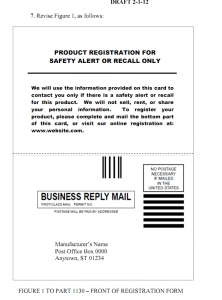There has been a lot of confusion on what information needs to be included in a Children’s Product Certificate (CPC). While the Consumer Product Safety Commission (CPSC) has not given any guidance on the format of a CPC they have given detailed instructions on the type of information which needs to be included in a CPC (Final Rule, 16 CFR Part 1110, Certificates of Compliance dated November 18, 2008).
There are seven (7) major areas of information which at a minimum must be on each CPC and they include;
1. Identification of the product covered by this certificate:
The information provided here must be more than just the common name of the product as it is known by the consumer or retailer. It must contain model, item or SKU number to uniquely identify the product from other products manufactured or imported by the issuer of the certificate. The CPSC has allowed for “family” of products to be listed on the certificate where the testing has been the same or when the issuer is citing one laboratory report to show compliance for the whole family of products as for an example; the issuer had a stuffed bear that was in a variety of fabric colors and each color was a different item or SKU number and the testing was the same for each item or SKU number then one certificate could be issued for the family of bear products.
2. Citation to each CPSC product safety regulation to which this product is being certified:
Each CPSC product safety regulation must be listed which builds the case for compliance of the product. The safety regulation must be identified so that there might not be any confusion as to what the safety regulation is. As for example; if the product was tested for small parts then the safety regulation would be cited as, ASTM F963-08 (or most current version) Section 4.6 Small Parts.
3. Identification of the U.S. importer or domestic manufacturer certifying compliance of the product:
The information provided here MUST be the company name, full mailing address and telephone number of the manufacturer or importer of record certifying the product.
4. Contact information for the individual maintaining records of test results:
The information provided here MUST be the company name, full mailing address, e-mail address and telephone number of the person maintain test records for the company in support of the certification of the product.
5. Date and place where this product was manufactured:
The information provided can be the date or dates when the product was manufactured using at least a month and year format (MM/YYYY). The place of manufacture needs to be identified as well with AT LEAST the city and country or administrative region of the place where the product was finally manufactured or assembled. If the factory that produced the product has more than one location in the city listed then the street address of the factory will be used to further identify the place of manufacture.
6. Date and place where this product was tested for compliance with the regulation(s) cited above:
Information provided here must be the date or dates of the testing on the test reports, the report numbers and the location or locations of testing.
7. Identification of any third-party laboratory on whose testing the certificate depends:
The third-party laboratory which tested the product for conformity must be listed with AT LEAST their name, full mailing address and telephone number of the laboratory.
At the recent Toy Fair conference, Neil Cohen, Small Business Ombudsman of the CPSC announced that companies can use the same certificate and add Production Run / Tracking label information to it for each production run in the testing calendar year as long as there is no material change in that batch or run. This will give companies the option of consolidating certificates under each product. As more information regarding this practice becomes available, I will share it on this site.
Remember that the issuance of Children’s Product Certificates is the responsibility of the manufacturer and it is their duty to provide access to these reports with each sale to retailers. CPC’s are not required when selling directly to consumers.
Bill Jacoby is the principal at Jacoby Solutions which has developed a CPSIA Operational Readiness CORE Audit to help companies identify risk and improve their company’s business operations.


